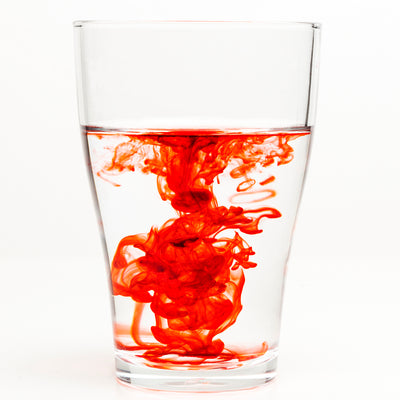Eric Roy, PhD & Analies Dyjak, M.A.
The Red Dye Test is a visual demonstration used in marketing materials by various water filtration companies. In this demonstration, red food coloring is added to water and passed through a filter, where it comes out clear. Oftentimes this demonstration is done in a “side by side” manner against another water filter that does not remove the red coloring from the water. This demonstration suggests to the consumer that:-
If a water filter can remove red dye, it’s also removing dangerous contaminants. In scientific terms, they’re suggesting that red dye is a “proxy” or “surrogate” for dangerous contaminants.
-
Water filters that do not remove the red color are not as effective as water filters that do remove red food coloring.
Is Red Food Coloring a Representative Proxy or Surrogate for Contaminants in Drinking Water?
Absolutely not. Identifying a representative proxy/surrogate requires that a credible testing body (e.g NSF/ANSI) has actually done experiments to validate it. An example of a representative surrogate test is NSF/ANSI Standard 53 for VOCs, where the certifying bodies have shown (through testing) that chloroform is an effective surrogate for roughly 50 VOCs. No such testing has been done (or to our knowledge attempted) for red food coloring. It goes without saying, if the visual removal of red food coloring was a representative surrogate for water filter performance, credible water filter companies would not be spending millions of dollars on research, development, testing, and evaluation.
Are Water Filters That Do Not Remove Red Food Coloring Less Effective At Removing Dangerous Chemicals?
Absolutely not. For example, one of the brands that prominently markets using the red dye test was part of a water filter evaluation study conducted by Duke and NC State University, and failed miserably. Conversely, various products that do not remove red food coloring (Hydroviv’s included) were effective in filtering “hard-to-filter” PFAS from the challenge solutions. So while the brand effectively removes food-safe red dye, it isn’t able to remove PFAS. In fact, higher levels of PFAS were detected in the filtered water because the filtration media was likely oversaturated. In short, red dye is extremely easy to remove and is not an actual indication of filter performance or contaminant removal.
Is There a Quick and Easy Way To See if My Filter is Working?
While we wish there was an at-home test that could determine if your filter is doing its job, that unfortunately isn’t the case. Every home in America would test their water on a regular basis if at-home test kits provided actual information about water quality. If you want to test for contaminants, you’ll need to send a water sample to an accredited laboratory and test for a range of contaminants. This can cost thousands of dollars and doesn’t provide immediate results. The best way to ensure that you’re using an effective product is to buy products from companies that use third party testing & certifications.
Summary: The Red Dye Test is a Marketing Gimmick
The red dye test tells us almost nothing about filtration performance and shouldn’t be used as a proxy/surrogate for harmful contaminants.
Other Articles Recommended For You:Stop Using TDS/ppm Testers to Evaluate Water Quality
What Are Per and Polyfluoroalkyl Substances (PFAS)?
Why Some Water Filters Are More Effective Than Others






